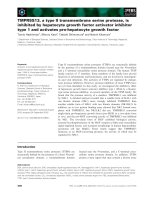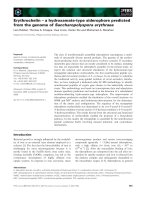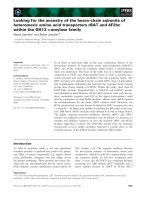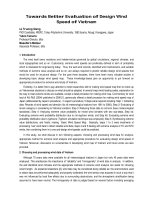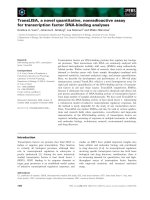Tài liệu Báo cáo khoa học: "Towards a Computational Treatment of Superlatives" pptx
Bạn đang xem bản rút gọn của tài liệu. Xem và tải ngay bản đầy đủ của tài liệu tại đây (88.25 KB, 6 trang )
Proceedings of the ACL 2007 Student Research Workshop, pages 67–72,
Prague, June 2007.
c
2007 Association for Computational Linguistics
Towards a Computational Treatment of Superlatives
Silke Scheible
Institute for Communicating and Collaborative Systems (ICCS)
School of Informatics
University of Edinburgh
Abstract
I propose a computational treatment of su-
perlatives, starting with superlative con-
structions and the main challenges in
automatically recognising and extracting
their components. Initial experimental evi-
dence is provided for the value of the pro-
posed work for Question Answering. I also
briefly discuss its potential value for Sen-
timent Detection and Opinion Extraction.
1 Introduction
Although superlatives are frequently found in
natural language, with the exception of recent work
by Bos and Nissim (2006) and Jindal and Liu
(2006), they have not yet been investigated within
a computational framework. And within the
framework of theoretical linguistics, studies of su-
perlatives have mainly focused on particular se-
mantic properties that may only rarely occur in
natural language (Szabolcsi, 1986; Heim, 1999).
My goal is a comprehensive computational
treatment of superlatives. The initial question I ad-
dress is how useful information can be automati-
cally extracted from superlative constructions. Due
to the great semantic complexity and the variety of
syntactic structures in which superlatives occur,
this is a major challenge. However, meeting it will
benefit NLP applications such as Question An-
swering, Sentiment Detection and Opinion Extrac-
tion, and Ontology Learning.
2 What are Superlatives?
In linguistics, the term “superlative” describes a
well-defined class of word forms which (in Eng-
lish) are derived from adjectives or adverbs in two
different ways: Inflectionally, where the suffix -est
is appended to the base form of the adjective or
adverb (e.g. lowest, nicest, smartest), or analyti-
cally, where the base adjective/adverb is preceded
by the markers most/least (e.g. most interesting,
least beautiful). Certain adjectives and adverbs
have irregular superlative forms: good (best), bad
(worst), far (furthest/farthest), well (best), badly
(worst), much (most), and little (least).
In order to be able to form superlatives, adjec-
tives and adverbs must be gradable, which means
that it must be possible to place them on a scale of
comparison, at a position higher or lower than the
one indicated by the adjective/adverb alone. In
English, this can be done by using the comparative
and superlative forms of the adjective or adverb:
[1] (a) Maths is more difficult than Physics.
(b) Chemistry is less difficult than Physics.
[2] (a) Maths is the most difficult subject at school.
(b) History is the least difficult subject at school.
The comparative form of an adjective or adverb is
commonly used to compare two entities to one an-
other with respect to a certain quality. For exam-
ple, in [1], Maths is located at a higher point on the
difficulty scale than Physics, and Chemistry at a
lower point. The superlative form of an adjective
is usually used to compare one entity to a set of
other entities, and expresses the end spectrum of
the scale: In [2], Maths and History are located at
the highest and lowest points of the difficulty
scale, respectively, while all the other subjects at
school range somewhere in between.
3 Why are Superlatives Interesting?
From a computational perspective, superlatives
are of interest because they express a comparison
67
between a target entity (indicated in bold) and its
comparison set (underlined), as in:
[3] The blue whale is the largest mammal.
Here, the target blue whale is compared to the
comparison set of mammals. Milosavljevic (1999)
has investigated the discourse purpose of different
types of comparisons. She classifies superlatives as
a type of set complement comparison, whose pur-
pose is to highlight the uniqueness of the target
entity compared to its contrast set.
My initial investigation of superlative forms
showed that there are two types of relation that
hold between a target and its comparison set:
Relation 1: Superlative relation
Relation 2: IS-A relation
The superlative relation specifies a property which
all members of the set share, but which the target
has the highest (or lowest) degree or value of. The
IS-A (or hypernymy) relation expresses the mem-
bership of the target in the comparison class (e.g.
its parent class in a generalisation hierarchy). Both
of these relations are of great interest from a rela-
tion extraction point of view, and in Section 6, I
discuss their use in applications such as Question
Answering (QA) and Sentiment Detection and
Opinion Extraction. That a computational treat-
ment of superlatives is a worthwhile undertaking is
also supported by the frequency of superlative
forms in ordinary text: In a 250,000 word subcor-
pus of the WSJ corpus
1
I found 602 instances
(which amounts to roughly one superlative form in
every 17 sentences), while in the corpus of animal
encyclopaedia entries used by Milosavljevic
(1999), there were 1059 superlative forms in
250,000 words (about one superlative form in
every 11 sentences).
2
These results show signifi-
cant variation in the distribution of superlatives
across different text genres.
4 Elements of a Computational Treat-
ment of Superlatives
For an interpretation of comparisons, two things
are generally of interest: What is being compared,
and with respect to what this comparison is made.
Given that superlatives express set comparisons, a
1
www.ldc.upenn.edu/Catalog/LDC2000T43.html
2
In the following, these 250,000 word subcorpora will
be referred to as SubWSJ and SubAC.
computational treatment should therefore help to
identify:
a) The target and comparison set
b) The type of superlative relation that holds be-
tween them (cf. Relation 1 in Section 3)
However, this task is far from straightforward,
firstly because superlatives occur in a variety of
different constructions. Consider for example:
[4] The pipe organ is the largest instrument.
[5] Of all the musicians in the brass band, Peter plays
the largest instrument.
[6] The human foot is narrowest at the heel.
[7] First Class mail usually arrives the fastest.
[8] This year, Jodie Foster was voted best actress.
[9] I will get there at 8 at the earliest.
[10] I am most tired of your constant moaning.
[11] Most successful bands are from the U.S.
All these examples contain a superlative form
(bold italics). However, they differ not only in their
syntactic structure, but also in the way in which
they express a comparison. Example [4] contains a
clear-cut comparison between a target item and its
comparison set: The pipe organ is compared to all
other instruments with respect to its size. However,
although the superlative form in [4] occurs in the
same noun phrase as in [5], the comparisons differ:
What is being compared in [5] is not just the in-
struments, but the musicians in the brass band with
respect to the size of the instrument that they play.
In example [6], the target and comparison set are
even less easy to identify. What is being compared
here is not the human foot and a set of other enti-
ties, but rather different parts of the human foot. In
contrast to the first two examples, this superlative
form is not incorporated in a noun phrase, but oc-
curs freely in the sentence. The same applies to
fastest in example [7], which is an adverbial super-
lative. The comparison here is between First Class
mail and other mail delivery services. Finally, ex-
amples [8] to [11] are not proper comparisons: best
actress in [8] is an idiomatic expression, earliest in
[9] is part of a so-called PP superlative construc-
tion (Corver and Matushansky, 2006), and [10] and
[11] describe two non-comparative uses of most, as
an intensifier and a proportional quantifier, respec-
tively (Huddleston and Pullum, 2002).
Initially, I will focus on cases like [4], which I
call IS-A superlatives because they make explicit
the IS-A relation that holds between target and
comparison set (cf. Relation 2 in Section 3). They
68
are a good initial focus for a computational ap-
proach because both their target and comparison
set are explicitly realised in the text (usually,
though not necessarily, in the same sentence).
Common surface forms of IS-A superlatives in-
volve the verb “to be” ([12]-[14]), appositive posi-
tion [15], and other copula verbs or expressions
([16] and [17]):
[12] The blue whale is the largest mammal.
[13] The blue whale is the largest of all mammals.
[14] Of all mammals, the blue whale is the largest.
[15] The largest mammal, the blue whale, weighs
[16] The ostrich is considered the largest bird.
[17] Mexico claimed to be the most peaceful country
in the Americas.
IS-A superlatives are also the most frequent type of
superlative comparison, with 176 instances in
SubWSJ (ca. 30% of all superlative forms), and
350 instances in SubAC (ca. 33% of all superlative
forms).
The second major problem in a computational
treatment of superlatives is to correctly identify
and interpret the comparison set. The challenge lies
in the fact that it can be restricted in a variety of
ways, for example by preceding possessives and
premodifiers, or by postmodifiers such as PPs and
various kinds of clauses. Consider for example:
[18] VW is [Europe’s largest maker of cars].
[19] VW is [the largest European car maker with this
product range].
[20] VW is [the largest car maker in Europe] with an
impressive product range.
[21] In China, VW is by far [the largest car maker].
The phrases of cars and car in [18] and [19]
both have the role of specifying the type of maker
that constitutes the comparison set. The phrases
Europe’s, European and in Europe occur in deter-
minative, premodifying, and postmodifying posi-
tion, respectively, but all have the role of restrict-
ing the set of car makers to the ones in Europe.
And finally, the “with” PP phrases in [19] and [20]
both occur in postmodifying position, but differ in
that the one in [19] is involved in the comparison,
while the one in [20] is non-restrictive. In addition,
restrictors of the comparison can also occur else-
where in the sentence, as shown by the PP phrase
and adverbial in [21]. It is evident that in order to
extract useful and reliable information, a thorough
syntactic and semantic analysis of superlative con-
structions is required.
5 Previous Approaches
5.1 Jindal and Liu (2006)
Jindal and Liu (2006) propose the study of com-
parative sentence mining, by which they mean the
study of sentences that express “an ordering
relation between two sets of entities with respect to
some common features” (2006). They consider
three kinds of relations: non-equal gradable (e.g.
better), equative (e.g. as good as) and superlative
(e.g. best). Having identified comparative sen-
tences in a given text, the task is to extract com-
parative relations from them, in form of a vector
like (relationWord, features, entityS1, entityS2),
where relationWord represents the keyword used
to express a comparative relation, features are a set
of features being compared, and entityS1 and enti-
tyS2 are the sets of entities being compared, where
entityS1 appears to the left of the relation word and
entityS2 to the right. Thus, for a sentence like
“Canon’s optics is better than those of Sony and
Nikon”, the system is expected to extract the vector
(better, {optics}, {Canon}, {Sony, Nikon}).
For extracting the comparative relations, Jindal
and Liu use what they call label sequential rules
(LSR), mainly based on POS tags. Their overall F-
score for this extraction task is 72%, a big im-
provement to the 58% achieved by their baseline
system. Although this result suggests that their sys-
tem represents a powerful way of dealing with su-
perlatives computationally, a closer inspection of
their approach, and in particular of the gold stan-
dard data set, reveals some serious problems.
Jindal and Liu claim that for superlatives, the
entityS2 slot is “normally empty” (2006). Assum-
ing that the members of entityS2 usually represent
the comparison set, this is somewhat counter-
intuitive. A look at the data shows that even in
cases where the comparison set is explicitly men-
tioned in the sentence, the entityS2 slot remains
empty. For example, although the comparison set
in [22] is represented by the string these 2nd gen-
eration jukeboxes ( ipod , archos , dell , samsung ),
it is not annotated as entityS2 in the gold standard:
[22] all reviews i 've seen seem to in-
dicate that the creative mp3 jukeboxes
have the best sound quality of these
2nd generation jukeboxes ( ipod , ar-
chos , dell , samsung ) .
(best, {sound quality}, {creative mp3 jukeboxes}, { })
Jindal and Liu (2006)
69
Furthermore, Jindal and Liu do not distinguish
between different types of superlatives. In con-
structions where the superlative form is incorpo-
rated into an NP, Jindal and Liu consistently inter-
pret the string following the superlative form as a
“feature”, which is appropriate for cases like [22],
but does not apply to superlative sentences involv-
ing the copula verb “to be” (as e.g. in [4]), where
the NP head denotes the comparison set rather than
a feature. A further major problem is that restric-
tions on the comparison set as the ones discussed
in Section 4 and negation are not considered at all.
Therefore, the reliability of the output produced by
the system is questionable.
5.2 Bos and Nissim (2006)
In contrast to Jindal and Liu (2006), Bos and
Nissim’s (2006) approach to superlatives is explic-
itly semantic. They describe an implementation of
a system that can automatically detect superlatives,
and determine the correct comparison set for at-
tributive cases, where the superlative form is in-
corporated into an NP. For example in [23], the
comparison set of the superlative oldest spans from
word 3 to word 7:
[23]
wsj00 1690 [ ] Scope: 3-7
The oldest bell-ringing group in the
country , the Ancient Society of Col-
lege Youths , founded in 1637 , re-
mains male-only , [ ] .
(Bos and Nissim 2006)
Bos and Nissim’s system, called DLA (Deep Lin-
guistic Analysis), uses a wide-coverage parser to
produce semantic representations of superlative
sentences, which are then exploited to select the
comparison set among attributive cases. Compared
with a baseline result, the results for this are very
good, with an accuracy of 69%-83%.
The results are clearly very promising and show
that comparison sets can be identified with high
accuracy. However, this only represents a first step
towards the goal of the present work. Apart from
the superlative keyword oldest, the only informa-
tion example [23] provides is that the comparison
set spans from word 3 to word 7. However, what
would be interesting to know is that the target of
the comparison appears in the same sentence and
spans from word 9 to word 14 (the Ancient Society
of College Youths). Furthermore, no analysis of the
semantic roles of the constituents of the resulting
string is carried out: We lose the information that
the Ancient Society of College Youths IS-A kind of
bell-ringing group, and that the set of bell-ringing
groups is restricted in location (in the country).
6 Applications
The proposed work will be beneficial for a vari-
ety of areas in NLP, for example Question An-
swering (QA), Sentiment Detection/Opinion Ex-
traction, Ontology Learning, or Natural Language
Generation. In this section I will discuss applica-
tions in the first two areas.
6.1 Question Answering
In open-domain QA, the proposed work will be
useful for answering two question types. A super-
lative sentence like [24], found in a corpus, can be
used to answer both a factoid question [25] and a
definition question [26]:
[24] A: The Nile is the longest river in the world.
[25] Q: What is the world’s longest river?
[26] Q: What is the Nile?
Here I will focus on the latter. The common as-
sumption that superlatives are useful with respect
to answering definition questions is based on the
observation that superlatives like the one in [24]
both place an entity in a generalisation hierarchy,
and distinguish it from its contrast set.
To investigate this assumption, I carried out a
study involving the TREC QA “other” question
nuggets
3
, which are snippets of text that contain
relevant information for the definition of a specific
topic. In a recent study of judgement consistency
(Lin and Demner-Fushman, 2006), relevant nug-
gets were judged as either 'vital' or 'okay' by 10
different judges rather than the single assessor
standardly used in TREC. For example, the first
three nuggets for the topic “Merck & Co.” are:
[27] Qid 75.8: 'other' question for target Merck & Co.
75.8 1 vital World's largest drug company.
75.8 2 okay Spent $1.68 billion on RandD in
1997.
75.8 3 okay Has experience finding new uses
for established drugs.
(taken from TREC 2005; 'vital' and 'okay' reflect
the opinion of the TREC evaluator.)
My investigation of the nugget judgements in
Lin and Demner-Fushman's study yielded two in-
3
70
teresting results: First of all, a relatively high pro-
portion of relevant nuggets contains superlatives:
On average, there is one superlative nugget for at
least half of the TREC topics. Secondly, of 69
superlative nuggets altogether, 32 (i.e. almost half)
are judged “vital” by more than 9 assessors.
Furthermore, I found that the nuggets can be dis-
tinguished by how the question target (i.e. the
TREC topic, referred to as T1) relates to the super-
lative target (T2): In the first case, T1 and T2 coin-
cide (referred to as class S1). In the second one, T2
is part of or closely related to T1, or T2 is part of
the comparison set (class S2). In the third case, T1
is unrelated or only distantly related to T2 (S3).
Table 1 shows examples of each class:
T1
nugget (T2 in bold)
S1
Merck & Co. World's largest drug company
S2
Florence
Nightingale
Nightingale Medal highest
international nurses award
S3
Kurds Irbil largest city controlled by
Kurds
Table 1. Examples of superlative nuggets.
Of the 69 nuggets containing superlatives, 46
fall into subclass S1, 15 into subclass S2 and 8 into
subclass S3. While I noted earlier that 32/69 (46%)
of superlative-containing nuggets were judged vital
by more than 9 assessors, these judgements are not
equally distributed over the subclasses: Table 2
shows that 87% of S1 judgements are 'vital', while
only 38% of S3 judgements are.
number of
instances
% of “vital”
judgements
% of “okay”
judgements
S1
46 87% 13%
S2
15 59% 40%
S3
8 38% 60%
Table 2. Ratings of the classes S1, S2, and S3.
These results strongly suggest that the presence
of superlatives, and in particular S1 membership, is
a good indicator of the importance of nuggets, and
thus for answering definition questions. Some ex-
periments carried out in the framework of TREC
2006 (Kaisser et al., 2006), however, showed that
superlatives alone are not a winning indicator of
nugget importance, but S1 membership may be. A
similar simple technique was used by Ahn et al.
(2005) and by Razmara and Kosseim (2007). All
just looked for the presence of a superlative and
raised the score without further analysing the type
of superlative or its role in the sentence. This calls
for a more sophisticated approach, where class S1
superlatives can be distinguished.
6.2 Sentiment Detection/Opinion Extraction
Like adjectives and adverbs, superlatives can be
objective or subjective. Compare for example:
[28] The Black Forest is the largest forest in
Germany. [objective]
[29] The Black Forest is the most beautiful area
in Germany. [subjective]
So far, none of the studies in sentiment detection
(e.g. Wilson et al., 2005; Pang et al., 2002) or opin-
ion extraction (e.g. Hu and Liu, 2004; Popescu and
Etzioni, 2005) have specifically looked at the role
of superlatives in these areas.
Like subjective adjectives, subjective superla-
tives can either express positive or negative opin-
ions. This polarity depends strongly on the adjec-
tive or adverb that the superlative is derived from.
4
As superlatives place the adjective or adverb at the
highest or lowest point of the comparison scale (cf.
Section 2), the question of interest is how this af-
fects the polarity of the adjective/adverb. If the
intensity of the polarity increases in a likewise
manner, then subjective superlatives are bound to
express the strongest or weakest opinions possible.
If this hypothesis holds true, an “extreme opinion”
extraction system could be created by combining
the proposed superlative extraction system with a
subjectivity recognition system that can identify
subjective superlatives. This would clearly be of
interest to many companies and market researchers.
Initial searches in Hu and Liu’s annotated cor-
pus of customer reviews (2004) look promising.
Sentences in this corpus are annotated with infor-
mation about positive and negative opinions,
which are located on a six-point scale, where [+/-3]
stand for the strongest positive/negative opinions,
and [+/-1] stand for the weakest positive/negative
opinions. A search for annotated sentences con-
taining superlatives shows that an overwhelming
majority are marked with strongest opinion labels.
7 Summary and Future Work
This paper proposed the task of automatically ex-
tracting useful information from superlatives oc-
4
It may, however, also depend on whether the superla-
tive expresses the highest ('most') or the lowest ('least')
point in the scale.
71
curring in free text. It provided an overview of su-
perlative constructions and the main challenges
that have to be faced, described previous computa-
tional approaches and their limitations, and dis-
cussed applications in two areas in NLP: QA and
Sentiment Detection/Opinion Extraction.
The proposed task can be seen as consisting of
three subtasks:
TASK 1: Decide whether a given sentence contains
a superlative form
TASK 2: Given a sentence containing a superlative
form, identify what type of superlative it is (ini-
tially: IS-A superlative or not?)
TASK 3: For set comparisons, identify the target
and the comparison set, as well as the superlative
relation
Task 1 can be tackled by a simple approach rely-
ing on POS tags (e.g. JJS and RBS in the Penn
Treebank tagset). For Task 2, I have carried out a
thorough analysis of the different types of superla-
tive forms and postulated a new classification for
them. My present efforts are on the creation of a
gold standard data set for the extraction task. As
superlatives are particularly frequent in encyclo-
paedic language (cf. Section 3), I am considering
using the Wikipedia
5
as a knowledge base. The
main challenge is to devise a suitable annotation
scheme which can account for all syntactic struc-
tures in which IS-A superlatives occur and which
incorporates their semantic properties in an ade-
quate way (semantic role labelling). Finally, for
Task 3, I plan to use both manually created rules
and machine learning techniques.
Acknowledgements
I would like to thank Bonnie Webber and Maria
Milosavljevic for their helpful comments and sug-
gestions on this paper. Many thanks also go to
Nitin Jindal and Bing Liu, Johan Bos and Malvina
Nissim, and Jimmy Lin and Dina Demner-
Fushman for making their data available.
References
Kisuh Ahn, Johan Bos, James R. Curran, Dave Kor,
Malvina Nissim and Bonnie Webber. 2005.
Question Answering with QED. In Voorhees and
Buckland (eds.): The 14th Text REtrieval
Conference, TREC 2005.
5
www.wikipedia.org
Johan Bos and Malvina Nissim. 2006. An Empirical
Approach to the Interpretation of Superlatives. In
Proceedings of EMNLP 2006, pages 9-17, Sydney,
Australia.
Norbert Corver and Ora Matushansky. 2006. At our best
when at our boldest. Handout. TIN-dag, Feb. 4, 2006.
Irene Heim. 1999. Notes on superlatives. Ms., MIT.
Minqing Hu and Bing Liu. 2004. Mining Opinion Fea-
tures in Customer Reviews. In Proceedings of AAAI,
pages 755-760, San Jose, California, USA.
Rodney Huddleston and Geoffrey K. Pullum (eds.).
2002. The Cambridge grammar of the English lan-
guage. Cambridge: Cambridge University Press.
Michael Kaisser, Silke Scheible and Bonnie Webber.
2006. Experiments at the University of Edinburgh for
the TREC 2006 QA track. In Proceedings of TREC
2006, Gaithersburg, MD, USA.
Nitin Jindal and Bing Liu. 2006. Mining Comparative
Sentences and Relations. In Proceedings of AAAI,
Boston, MA, USA.
Jimmy Lin and Dina Demner-Fushman. 2006. Will
pyramids built of nuggets topple over? In Proceed-
ings of the HLT/NAACL, pages 383-390, New York,
NY, USA.
Maria Milosavljevic. 1999. The Automatic Generation
of Comparisons in Descriptions of Entities. PhD
Thesis. Microsoft Research Institute, Macquarie Uni-
versity, Sydney, Australia.
Bo Pang, Lillian Lee, and Shivakumar Vaithyanathan.
2002. Thumbs up? Sentiment classification using
machine learning techniques. In Proceedings of
EMNLP, pages 79-86, Philadelphia, PA, USA.
Ana-Maria Popescu and Oren Etzioni. 2005. Extracting
product features and opinions from reviews. In Pro-
ceedings of HLT/EMNLP-2005, pages 339-346, Van-
couver, British Columbia, Canada.
Majid Razmara and Leila Kosseim. 2007. A little
known fact is Answering Other questions using in-
terest-markers. In Proceedings of CICLing-2007,
Mexico City, Mexico.
Anna Szabolcsi. 1986. Comparative superlatives. In
MIT Working Papers in Linguistics (8). ed. by Naoki
Fukui, Tova R. Rapoport and Elisabeth Sagey. 245-
265.
Theresa Wilson, Janyce Wiebe and Paul Hoffmann.
2005. Recognizing Contextual Polarity in Phrase-
Level Sentiment Analysis. In Proceedings of
HLT/EMNLP 2005, pages 347-354, Vancouver, Brit-
ish Columbia, Canada.
72


